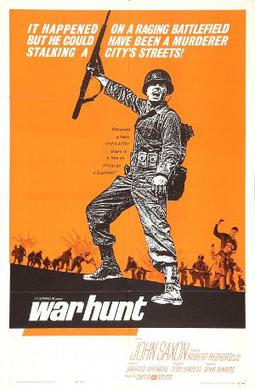“War Hunt” is another mediocre Korean War movie. I have to constantly remind myself that there
are a lot of bad World War II movies, too.
In fact, I have a collection of 50 of them. It just seems that the percentage of inferior
Korean War movies is the highest of any war.
My theory is that most of the movies were produced during the waning
days of Old School style. This makes
most of them seem stodgy. The war itself
did not help matters. The war was not
popular with the public and the studios realized this. For this reason, they seem to have not put
much effort into the movies. Movies
aimed at drive-ins are not going to be high quality.
“War Hunt” attempts to defy the stereotype by being
provocative. It was directed by Denis
Sanders who had a reputation for taking chances. As you can imagine, the studios were not that
interested in his outside the box ideas.
He only had $250,000 for his budget and made the movie in only 15
days. Much of the filming was done at
night due to the budget. No surprise
that the filmmaker got no help from the Pentagon because the script was not
exactly aimed at boosting recruiting or the military image! This is in spite of the opening narration
that mentions that the combat infantryman was the “tip of the spear”. Unfortunately, the Army read the rest of the
script.
The movie is set in the closing months of the
war. A small unit is part of the U.S.
effort to inflict pain to hurry along the peace negotiations. This is actually a cogent analysis of the
strategy of that time. A replacement
named Loomis (Robert Redford in his screen debut) arrives. The unit is regaled by loudspeaker
proclamations from Radio China and the Dragon Lady. Loomis is introduced to the unit’s resident
psycho serial killer named Endore (John Saxon).
Endore goes “AWOL in the wrong direction” each night. He uses a knife to kill enemy soldiers. The rest of the squad leaves him alone and
the CO condones his actions because it’s a dirty little war. Endore has adopted an orphaned little Korean
boy named Charlie who is part of the fine tradition of “Short Round” from
“Steel Helmet”. Loomis decides to challenge
Endore for the soul of the boy. Things
come to a head when the war ends and Endore is suddenly a murderer, not a
dedicated warrior.
“War Hunt” is a strange movie. It plays like an American Playhouse
drama. This is especially evident in the
lack of action. This was undoubtedly due
to the low budget. There is a scene when
Loomis is on outpost duty. The Chinese
attack. The bombardment is not bad for a
small movie and the sound effects are good.
Since it is necessarily at night. flares and lights are used
effectively. The assault is more of a
human ripple than a human wave. but it’s not a bad effort.
The best thing about the movie is the cast. It includes Gavin McLeod, Tom Skerritt, and Sydney Pollack. Pollack and Redford began a friendship which led to
collaboration in seven movies directed by Pollack. Redford acquits himself well in his
debut. He definitely comes off as a
future star. Even then he had a clause
in his contract that his hair could not be messed with. Saxon underplays Endore effectively. The movie uses eerie flute music and snare
drums and some POV to depict how unhinged his character is.
You have to give the movie credit for being
different. The theme reflects the fact
that some Korean War movies anticipated the Vietnam War movies in their
cynicism. In this case, the statement is
that killing is fine as long as there is a war on, then what?
GRADE =
C+




